Horror films - 2015
| Krampus | Goosebumps | The Visit |
| Insidious: Chapter 3 | Poltergeist | Maggie |
| Unfriended | It Follows | The Lazarus Effect |
| The Woman in Black: Angel of Death |
____________________
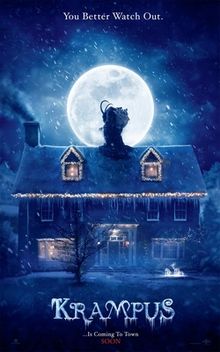 |
You better watch out . . .
Perhaps our collective Christmas spirit has decayed to the point where we have less of a taste for cute and heart-warming Christmas stories than we used to. Krampus comes along as a word of warning - keep that spirit alive or yule be sorry.
Krampus centers around the 3 days leading up to Christmas for Max (Emjay Anthony) as his family hosts a gaggle of boorish relatives. Max is right at the stage of finding out Santa is more tradition than fact, though his German-speaking grandmother, "Omi" (Krista Sadler), tries to keep him believing. But after his thuggish cousins finally push him too far, he angrily rejects the Christmas spirit - leaving the door open to its grisly alternative.
Krampus may be a Christmas season movie and it has its humorous moments, but it's not for the faint of heart. Director Michael Dougherty does a good job of building suspense as the family comes face to face with Krampus and the assortment of frightening minions that herald his arrival.
There are several quality performances in Krampus. Emjay Anthony is believable and smpathetic as Max, who carries us through this cautionary tale. Adam Scott and Toni Collette are similary likable as Max's well-meaning, if not quite perfect, parents. Standout performances amongst the clownishly awful relatives are David Koechner as Max's oversized, macho-man uncle and Conchata Ferrell as his great-aunt from Hell. Krista Sadler does a nice job of playing maternal and ominous as the wise lady from the old country who knows exactly what is going on.
I don't have that many quibbles about Krampus, but I wasn't expecting Shakespeare. It's a moral fable about the consequences of cruelty and giving up on hope and faith. It gets downright gruesome at times, but no more so than a classic Grimm's fable. The ending is a bit ambiguous, but I think this was the director's intent - scary to adults but white-washable for kids.
In all, Krampus looks good, has a fitting score, and is well-acted. It stands as an addition to the Christmas film library, as a word of warning. You'd better not pout, you'd better not cry. It's not just Santa who sees you when you're sleeping. And it can be too late to say you're sorry.
- JC
____________________
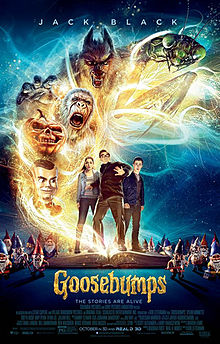 |
Not all of us are people who grew up on the scary - but not overly grusesome - Goosebumps stories of R.L. Stine. The age group between present-day young adults through those in their early 30's will likely have the most appreciation for all the little gems scattered through Goosebumps the movie. But even though I didn't fall into that group, I could still appreciate the story - a fantasy-fictionalization of the life of Stine himself - and all of the fantasy-horror elements in the film.
It's extremely apropos this film was released about 2 weeks before Halloween. Serious, scare-adults-to-death horror isn't so much for Halloween. Halloween is mostly for kids and Stine's scary-but-not-too-scary is a perfect fit.
In Goosebumps, we follow Zach (Dylan Minnette), a teenager who has just moved to a new community with his Mom, a new vice-principal at the very school he will be attending. Shortly after their arrival, he meets Hannah (Odeya Rush), the girl next door, as well as "Mr. Shivers" (Jack Black), her decidedly un-friendly father. Zach quickly develops a friendship with Hannah, as well as with Champ (Ryan Lee), a quirky kid from his new school. Complications quickly ensue as Zach decides something is amiss with Hannah and her Dad, and then "the twist," where things take a hard left into weird - Mr. Shivers is actually the writer R.L. Stine and in that world his fiction has actual life to it and his monstrous creations are capable of becoming real.
The plot isn't a great surprise - a fantasy-horror writer whose characters can become real. But it's a fitting homage to Stine's body of work. I mostly applaud the film's overall tone as orchestrated by director Rob Letterman. While Stine is central to the plot, young teens are his protagonists. And while they are definitely in peril and suffer setbacks, nothing too terribly awful ever occurs. Jack Black is just fine as the reclusive, eccentric, creative fictional Stine and it was a nice (and even logical) touch to have him voice some of his own creepy creations.
Goosebumps serves well as the best Halloween movie of the year and also as a playful tribute to Stine's works. (It even includes a slyly placed cameo by the real Stine, himself.) I gladly recommend it.
- JC
____________________
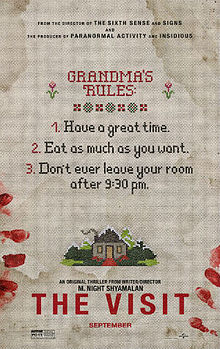 |
Can any director claim a past more checkered by successes and failures than M. Night Shyamalan? The same man who brought us such classics as The Sixth Sense, Unbreakable, Signs, and The Village, went on to direct Lady In the Water, The Happening, The Last Airbender, and After Earth. It's as if we were watching the slow descent of a director who, at some point, lost his muse. Now, Shyamalan retuns from recent high-budget efforts to a smaller-scale film. Many reviewers are saying "Shyamalan is back." Is he?
The Visit is the story of two kids sent to spend a week with their grandparents, whom they have never met. A bit of a mystery is set up early in the film, as we are informed that the kids' mother has been estranged from her parents for 15 years after she eloped with one of her high school teachers. But the details of exactly how she left are only alluded to vaguely as unpleasant and she doesn't want to talk about it. The film is shot from the perspective of the older sibling, Rebecca (Olivia DeJonge), an amateur film-maker who decides to document their visit. The movie revolves around Rebecca and her younger brother Tyler (Ed Oxenbould), a pre-teen who considers himself a budding rapper, acting precociously, filming their week, aping real documentarians, and alternating between being friendly to and privately disparaging their grandparents, John and Doris (Peter McRobbie and Deanna Dunagan). As the week goes on, the teens witness increasingly odd behavior on the parts of the grandparents. Early on, they dismiss it - "They're just old." But as things grow more and more strange, they begin to become more concerned.
The best parts of The Visit: The performances of the veteran actors playing John and Doris were very good, as they slid back and forth between endearing and menacing. I also appreciated the plot twist in the film that suddenly changes everthing. This is a Shyamalan trope and it's nice to see him using it again. And as in The Sixth Sense, I never saw it coming and kicked myself for not figuring it out before the reveal.
Quibbles: The acting skills of the teens may have been OK, but I found their characters mostly unlikable. Perhaps it's my age, but young people who obviously hold adults - especially the elderly - in such disdain and disrespect, I just want to throw into military school. This is also the third "found footage" film in a row (after seeing As Above, So Below and Project Almanac) where I was certain the story could have been much better told in the conventional way, instead of "as recorded by the characters." The found-footage approach is OK, if used once in a while and for a logical reason, but it has now become an alternate method of film-making for people who are bad at staging scenes and want to avoid paying for a score. It's a lame stylistic excuse for cheap and lazy film-making and it needs to end. (Rant over.)
So, is Shyamalan back? I don't think so, mostly because he didn't really leave. No one has only good ideas. It must be difficult to start your career with films of such high quality that you're always trying to re-capture that success. It's as if you aren't allowed to be just "OK." But Ridley Scott and Michael Mann, both very accomplished directors, don't hit it out of the park every time. Shyamalan deserves the right not to be perfect too.
The Visit isn't great, though it has its moments. Hopefully, it represents a step in the right direction for Shyamalan, back to smaller-scale stories with his signature twists. Like many other fans, I will keep rooting for him.
- JC
____________________
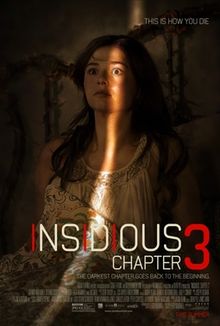 |
Honestly, my expectations were not very high for Insidious: Chapter Three. First, though chapters one and two delivered some scares, I always felt that the premise of the series was a bit flimsy and the practical effects in place of cgi, while interesting, sometimes seemed a bit theatrical and even silly. Second, by the time a horror film series reaches its third chapter, all the good original ideas have usually been used up and it's just repetitions of the same. Third, since I hadn't bothered to see either of the first two films until they were on Netflix, it seemed strange to even be paying to see this one. And fourth, this film was the first not to be directed by James Wan, who also directed Saw and Saw 2, The Conjuring, and a little movie released earlier this summer, called Furious 7. Instead, it was directed by Leigh Whannell, the writer of all three Insidious films, in his directorial debut.
But, Whannell showed us the same thing that Alex Garland did with Ex Machina, earlier this summer. Gifted writers, sometimes, can be gifted directors as well. I was pleasantly surprised with what seemed like better performances and better visuals in this film over its predecessors. It very successfully creates and maintains a sense of dread that runs through the entire film and delivers several potent shocks as well.
The story: Set a deliberately vague “few years” before the events of Insidious, we are introduced to the Brenner family – recently widowed Dad, Sean (Dermot Mulroney), who is raising a teenaged girl, Quinn (Stefanie Scott), and her younger brother, Alex (Tate Berney). Quinn has been trying to contact the spirit of her deceased mother and sought help from Elise (Lin Shaye), the spiritualist from the other films. Elise warns her of the potential consequences of trying to reach out to the dead and sends her away. Later, Quinn is progressively haunted in the usual stages – bothersome nuisances, leading to physical abuse, and eventually outright possession – by an evil entity in their home. In his desperation to save his daughter, Sean turns to Internet ghost-hunters Tucker (Angus Sampson) and Specs (writer/director Leigh Whannell) for help. They are eventually joined by Elise, who has had to come to terms with her own demons and is now prepared to help.
To me, the breakout performance in this film is actually given by Lin Shaye, as Elise, the self-doubting psychic. While she is sympathetic as a damaged, recently widowed woman who is also deeply disturbed by some of the evil she has encountered, she rises to the occasion for the story's climax. She is essentialy a silver-haired, supernatural “Ripley” by the end, facing down a demon with an almost familiar “come on, bitch!” There have been some reviews that mocked Shaye's tough performance, but most of the mockery has been age based, which is (in my opinion) beneath contempt.
The ending is left open for “prequel-sequels” which could actually be fun, if well-written and directed. From what I have seen here, Whannell would be up to the task.
- JC
____________________
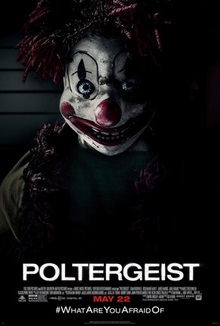 |
So, the biggest question on the minds of most of us regarding the re-make of Poltergeist (1982), the horror classic by Tobe Hooper and Steven Spielberg, is did this movie really need to be re-made? The original was a ground-breaking certifiable supernatural-horror classic, with some of the most gifted film-makers and performers of the day. Films are usually re-made because a new film-maker thinks they have something to add - a significant "new spin" - to put on the original. This new version is helmed by director Gil Kenan and producer Sam Raimi, the man behind the Evil Dead and first Spider-man film series. So what did Poltergeist (2015) have to add to 1982's classic? Not enough to justify a re-make, I'm sorry to say.
The basic plot is the same as before. A family moves into a house where they soon encounter supernatural phenomena. A child is particularly imperiled and the family calls on paranormal specialists for help. So, how does it differ from the original?
It is substantially shorter. The original has a 114 minute runtime, while the re-make a mere 93 minutes. One might argue this is to better hold short attention spans of modern audiences, but the practical effect is that is cuts into the story and character development time. And the notion that audiences now can't pay attention as long is outright insulting.
As mentioned, character development suffers in this film. The starkest contrast is the character of the Mom. Jobeth Williams was almost Ripley-esque in her fierce protection of her children in the original, while poor Rosemarie DeWitt really isn't given much to do except occasionally remind her husband that he needs to be an adult. Sam Rockwell, as the Dad, has occasional script attempts to give him some dimension, but he is never as credible or likeable as Craig T. Nelson's character. There is some attempt to make the paranormal investigators a bit comical and, given the circumstances of the story, that seems out of place. The only fleshing out of a character that was a nice touch, was making Griffin (Kyle Catlett), the middle child and son, have issues with confronting his fears and his feelings of guilt over what happens to his younger sister, Madison (Kennedi Clements).
Kenan and Raimi's main "new spin" on Poltergeist is seeing more of "the other side." But honestly, their concept of the supernatural realm is really just a "trick-or-treat" goulish-looking environment, not so different from that of other Raimi fright features. If someone tried to realistically imagine what the dimension of the dead looked like, would this really be it? "The Further," the shadowy realm imagined in the Insidious film series seems more believable.
In short, skip this. It mostly gave me renewed appreciation for the original film. If you are curious about the story and haven't seen the original, that is the one to watch.
- JC
____________________
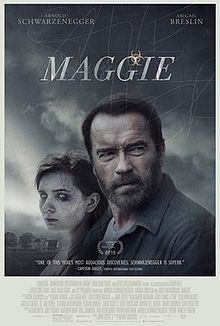 |
Zombies have practically become for the horror genre what time-travel is for science-fiction. We had our Brad Pitt entry, World War Z, a few years ago. The Walking Dead is one of the hottest series on TV. And now, the CW's iZombie tries to sell us on the idea of a zombie heroine. So, when one sees a zombie film that stars action legend Arnold Schwarzenegger, one forms certain expectations about the film. But, like last year's Only Lovers Left Alive, even though the story features horror fiction tropes, it is a very human drama. Maggie is a story of love, loyalty, and humanity in the face of inevitable, soul-crushing loss.
Maggie tells the tale of a farmer, Wade (Schwarzenegger), whose teen-aged daughter, Maggie (Abigail Breslin), has contracted a zombie virus which has caused widespread destruction, though society is still functioning. But there is no cure or treatment, and eventually the afflicted are quarantined in horrific mass facilities - often devouring one another - until their deaths. Wade resolves to keep Maggie at home as long as he can, despite the inherent danger she represents and pressure from local law enforcement. Relationships are explored as we see that Maggie is Wade's only child from his first wife and she has a step-mom, Caroline (Joely Richardson), and a younger half-brother and half-sister. As other members of their small community also grow sick and are taken away or put down, we know there is a ticking clock for Maggie and decisions must be made by her and her father as to how her story will play out.
So, the words “zombie” and “Schwarzenegger” create expectations which are not really met in this film, which is an emotionally-touching story about people dealing with tragedy. It's not really much of a horror film and even less of an adventure. On the other hand, if the girl had been dying of bubonic plague and her father had been played by any of several available character actors, it might not have even made it to TV. Regarding Schwarzenegger's performance, I really thought he did a nice job. And it's unfair to penalize someone who is doing good work now, because we are distracted by memories of him as a superstar in the past.
What Maggie does accomplish is to take a close, sympathetic look at an individual losing herself to this cruel illness and how it affects the people close to her. The killing of zombies en masse in movies, TV, and video games has desensitized us to the fact that these mindless husks you are chopping, shooting, or burning, were once someone's baby boy or girl. And in a society where people seem to care less and less for one another day by day, maybe that is a story we should pay some attention to. Because if we really reach the point where we don't care, then we will be the walking dead.
- JC
____________________
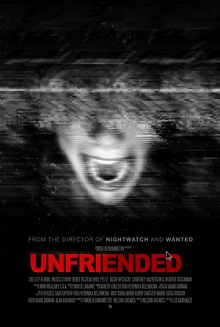 |
Unfriended is a horrifying movie alright, but not for the reasons you might think. In the movies, we've grown accustomed to hauntings and demonic activity. But the lowness of human behavior, that seems chillingly credible, makes one feel sick inside.
Unfriended was written by Nelson Greaves and directed by Levan Gavriadze. Production was a mere 16 days and the film's cost was only $1 million. The story is presented entirely from the point-of-view of one character's computer screen as she communicates with a group of friends one night.
Blair, played by Shelley Hennig (The Secret Circle, Teen Wolf), is conversing with her boyfriend from her bedroom late at night via Skype and Facebook. As the conversation gets progressively more sexual, suddenly some of their friends break into their conference call, accompanied by a mystery person. Peppered through their conversation are references to a friend who committed suicide a year earlier after having been humiliated online. Attempts to get rid of the mystery person fail and eventually the entity claims to be the dead girl and it demonstrates that it can reach them in their homes. It then terrorizes them with humiliating games as it begins eliminating them one by one.
Yes, the scares will make you jump and there are gruesome parts. But the true horror is the revelation of what these "friends" will do and say to one another to build themselves up and knock others down. What's doubly sad is how authentic their behavior seems - portraying themselves as attractive, powerful, and in-the-right while stabbing friends in the back.
I recall a conversation with a teen a few years ago, where I warned them that as their little group was mean to others, be conscious of the fact that you have surrounded yourself with mean people. How long do you really think it will be before they decide to take a bite out of you? Unfriended is a modern-day morality tale. By the end . . I was rooting for the ghost.
- JC
____________________
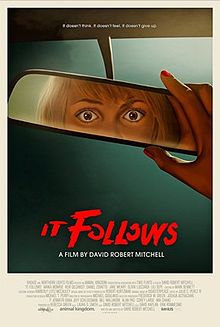 |
Kids can come up with some pretty creepy games. When I was young, I would play in the barn and pretend the floor was covered with poisonous snakes. The object of the game was to cross the room without stepping on the ground - climbing on the beams and rafters, hopping from object to object. When the movie Tremors came out, I figured the writers had played that game at some time too. Another creepy game? Stare at someone and walk towards them. Don't stop, just keep on walking. Of course they can run away. But everyone gets tired of running eventually.
It Follows was written and directed by David Robert Mitchell. It was filmed in Detroit, Michigan with a mere two million dollar budget. It debuted at the 2014 Cannes Film Festival to critical praise, since echoed by the majority of critics at Rotten Tomatoes and Metacritic.
Our story revolves around Jay, a pretty teen-aged girl. After a date with a handsome young man takes a dark and unexpected turn, she is then stalked by a malevolent non-speaking entity which can assume any form it chooses. But only she and others touched by the curse can see it. With the help of a handful of peers she struggles to stay alive and find a way out of her deadly predicament.
The most notable achievement of this film is the way it creates a nearly continuous sense of dread and anticipation for so much of the film. The source of her terror can take any form, appear at any moment, and is a formidable threat. It brought to mind the threat of the character, the Shadow from the film of the same name - "I'll be there . . . around every corner . . . in every empty room . . . " Maika Monroe, as Jay, convincingly displays her character's changing emotions - her initial light-heartedness, later her fear and confusion, and eventually desperation, resignation, and hope.
I did have a few quibbles. A lot of traveling, interaction with hospitals and police mostly seem to occur in a teen fantasy world without adults. Also, the score veers oddly from darkly atmospheric to cheesy-sounding synthesizers that sounded like cheap soundtracks from the 1980's sci-fi/horror schlock. Given all the awful old 1950's sci-fi television our group seemed to enjoy watching, perhaps the director was trying to tie the story to vintage B-movies, but the correlation doesn't quite match because he actually made this film a bit too well.
If you are looking for a horror film which will keep you on the edge of your seat and straining to guess what's going on and how our heroine is going to get out of this mess, you should enjoy this film. Given a similar premise, it falls short of the production values or storytelling quality of The Ring, but for a smaller-scale film, it does a good job.
And there are bound to be more. As cheaply as this film was made and as much attention as it has attracted, can It Follows 2 "follow" far behind?
- JC
____________________
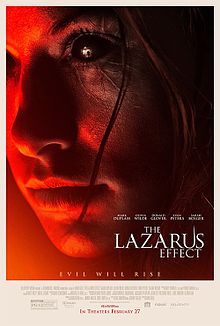 |
The Lazarus Effect, directed by David Gelb and starring Olivia Wilde, focuses on a team of medical researchers experimenting with resurrecting the dead. Trailers promoting this film seemed promising, but sadly, they told the story better than the film did.
David Gelb’s directorial credits are mostly documentaries, so perhaps this was part of the problem. But screenwriters Luke Dawson and Jeremy Slater will have to accept much of the blame. There doesn’t seem to be enough plot here for a whole movie. With a running time of only 83 minutes, one is tempted to think several minutes of story were edited out, but I doubt it. Given a typical three act structure, we have the setup and a climax, but the middle of the story is mostly missing - so much for a buildup of suspense.
The sad thing about the story is that it seemed very promising. One of the lead researchers, Zoe (Olivia Wilde), dies in a lab accident and the others resurrect her, with disastrous results. But the writers apparently couldn’t decide what story they were telling. Was Zoe different because of supernatural causes – resurrection after a stopover in Hell – or because of scientific factors – a drug wildly expanding the capabilities of her brain beyond what she could control (a horror movie version of Lucy)? Either approach could be effective, but for the audience to suspend its disbelief for this tale, a consistent premise needed to be established. Instead, they kept sidling from one to the other and back.
So, in spite of an interesting idea, where science runs abruptly up against the supernatural, this film descends rapidly into jump scares and grotesque imagery. It would be OK for a few chills on late night TV, but otherwise it’s mostly forgettable.
- JC
____________________
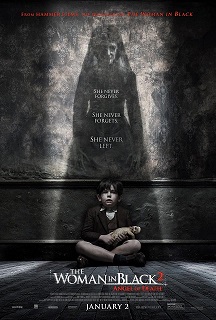 |
Wherever she's seen and whoever by One thing's for certain a child will die.
This ghoulish rhyme, uttered in The Woman in Black: Angel of Death, paraphrases the curse of the English town of Crythin Gifford and Eel Marsh house.
The events in this story occur 40 years after those in The Woman in Black. The german blitz of London during WWII has caused an evacuation of children from the city to the English countryside. This popular plot device, which served fantasy stories such as The Lion, the Witch, and the Wardrobe and Bednobs and Broomsticks to propel youngsters into imaginative adventures, is put to grimmer use here.
As in the previous film, and revealed to the protagonists of this film, a curse lies on Eel Marsh house and the town nearby. The malevolent spirit of a woman who killed herself after the death of a child that had been taken from her, haunts the area. Whenever she is seen, the death of a child follows soon thereafter. She knows what you fear and what you regret. She tortures you with visions. She never forgives. She never forgets.
The group of schoolchildren are sent to the house under the supervision of the school's no-nonsense headmistress and a young teacher, Eve (Phoebe Fox). One of the children was orphaned in the bombings just the night before their departure and has been silent since. On the train to the country, Eve mets a pilot, Harry (Jeremy Irvine), who is stationed near the town. Both he and Eve are haunted by psychological spectres from their pasts. When they arrive at the village, they find it nearly deserted, implicitly due to the effects of the curse.
This film re-captures the eerie quality of the first, but much of what made the first film interesting is missing here. Daniel Radcliffe's portrayl of the protagonist in the first film gave it more weight. With his history as the hero of the enormously successful Harry Potter series, the audience was all in as he experienced the frights of the old house and unravelled the mystery. Here, Phoebe Fox plays her part well, but the audience won't feel as bonded to her character as Radcliffe's. Also, the element of mystery is mostly gone. Nearly all viewers will already know the cause of the curse and how it plays out. We are simply seeing it affecting other people now. As derivative as this film is, it can't help but suffer from a lack of suspense.
Most critics have said similar things - well-acted, but the story is somewhat predictable. There has also been much criticism of the overuse of the horror trope of the "jump scare." A jump scare is when a character is in a quiet, eerie environment and the film injects either a sudden loud noise, the appearance of a frightening image by sudden movement within or from off frame, or both. Often, the jump scare has nothing to do with the cause of the suspense. The classic example: a girl creeps through her house feeling a killer is stalking her, she turns and suddenly a cat appears and hisses at her, often accompanied by a loud noise which shocks the viewer though it may have no cause in the scene. The overuse of this technique is becoming looked down on as a cheap trick and inferior to genuine horror connected to the story.
All in all, while this film delivers some chills and presents the personal stories and redemptions of a few of its main characters, it doesn't add anything new to the "Woman in Black" story itself. A story where someone endeavors to end the curse, as in the first film, could be interesting. But otherwise this franchise of a child-killing ghost might best be laid to rest instead.
- JC